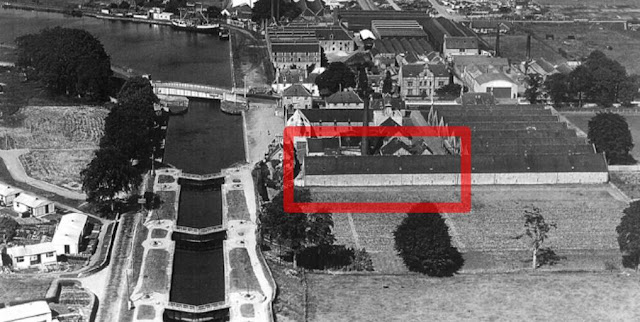Glen Mhor Logbook 26th December 1966
 |
| Warehouse 1 in red at the edge of the distillery site - note this is the largest warehouse but referred to as numbers 1 and 2, because it was extended in the 1890s |
'Dear Sirs
At 11am on 23/12/66, W. Hogg, one of two warehousemen on routine cask examination, reported to me that there had been a break-in through a skylight in the sediment of No.1 Warehouse. See sketch in the enclosure envelope.
I went at once to the section and found that the entry had been made by removing slates to expose the metal frame of the skylight which, held only by nails to the working, had then been lifted out leaving on the perforated gauge and then iron bars ??? across the opening. The gauge was burst open, and iron bar cut by hacksaw near its base and the centre bar forced out probably by jumping on it. The frame, the cut bar and the centre bar were left in the gutter outside the skylight. The exact time of entry is not known but I was in this warehouse section on the afternoon of 20/12/66 and there was then no sign of a break in.
By thorough visual examination and by check dipping a number of casks in the break-in area, I was satisfied that one cask only was pilfered. This was cask 1958/2042 C544 standing on its own ??? 12 feet away in the storage adjacent to the break in point with its bung removed. I took ??? of this cask and also of two remaining casks of the same parcel which were in different parts of the same warehouse section. Details are as follows: date of warehousing 1/11/58.
Cask 2042 at had ??? stave ends, 2043 was sound, and 2044 had ??? stave ends and leaking end joints. Pilferage could be any quantity up to about 12 proof gallons and is probably not less than 10 proof gallons ??? leaving regard to the fact that there has been some small leakage from ??? stave ends it may not be unreasonable to limit the charge for duty to 5.9 proof gallons and allow 4.9 as a special deficiency.
Officers of Inverness C.I.D. were quickly on the scene and after their examination the warehouse was made secure by nailing close fitting boards across the opening and slating overall in conformity with the rest of the warehouse roof. I am satisfied that this repair has enhanced the security of the warehouse and the traders intention is to leave it as it now is if approved by you. I checked all fire exit points and found them secure before locking the warehouse.
Approval for the action to secure the warehouse and instructions regarding the quantity for duty charge are requested please.
Your obedient servant.
G.S.H. Dawson
26/12/66
Result,
Duty charged 10.8
B.O. 142/67'
Thanks to excise records, we have a detailed synopsis of the point of entry, the method and the barrel chosen by the thieves.
What's interesting is that they chose an 8-year-old whisky. We know that Glen Mhor would have had older casks on site, but possibly not in this warehouse. Once inside, they chose a nearby cask for ease and a quick getaway if needed. Convenience is key, rather than seeking out the most valuable pour from a cask.
The following image, taken after the break-in, also shows that the skylights in Warehouse 1 have been replaced. Security has been increased to prevent a repeat of the break-in.
As always, I am fortunate to have Alan Winchester's insightful comments on these entries.
'The design of the then security required by Customs and Excise, was that any enforced entry could be clearly seen.
Yes, some distillery Duty Free Warehouses, had secret hatches, but this was clearly a damaging break in.
What's interesting is that the maturing casks were with cork bungs, common at the time, but now normally fitted with a hard bung (poplar), also the thieves knew a good dram.
With the sites becoming increasingly urban with the spread of the town, risk was increasing.'
What we do know is that the thieves did not attempt to repeat their successful raid. This remains the only recorded break-in at Glen Mhor. Had they had some of the 1960s/70s cask strength whiskies from the distillery, they would have been rewarded with a powerful orchestra of aromas and flavours. If only they'd kept a bottle of their nocturnal raid, I'd have loved to try it straight from the cask.
And we shouldn't over the look the festive timing, as it seems a reasonable assumption whatever amount of whisky was stolen, it was consumed over Hogmanay, just a few days later.
This Log Book comes from the Highland Archives Centre and is watermarked for its protection. As with any images on this website, please ask first before using and always give credit.



Comments
Post a Comment